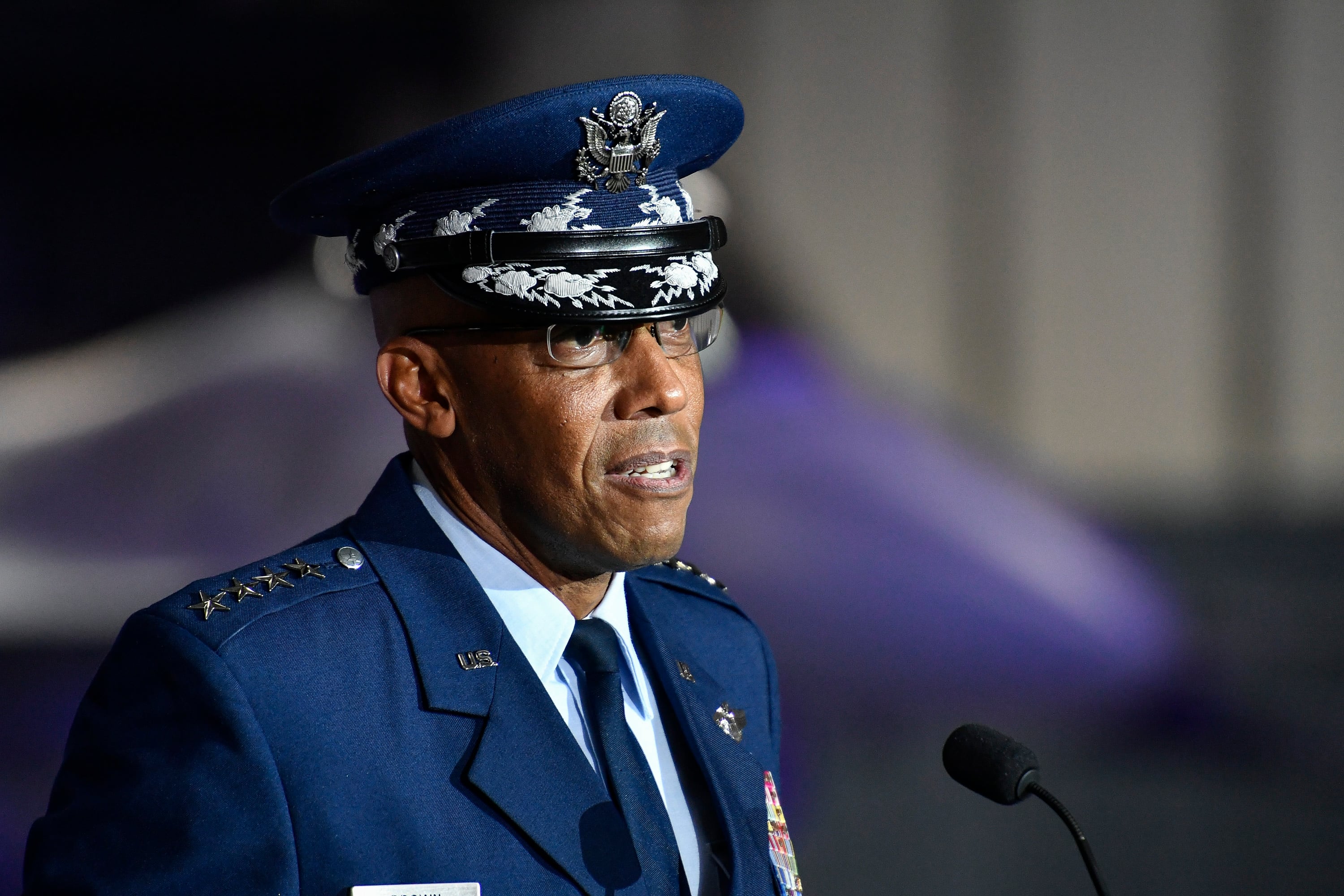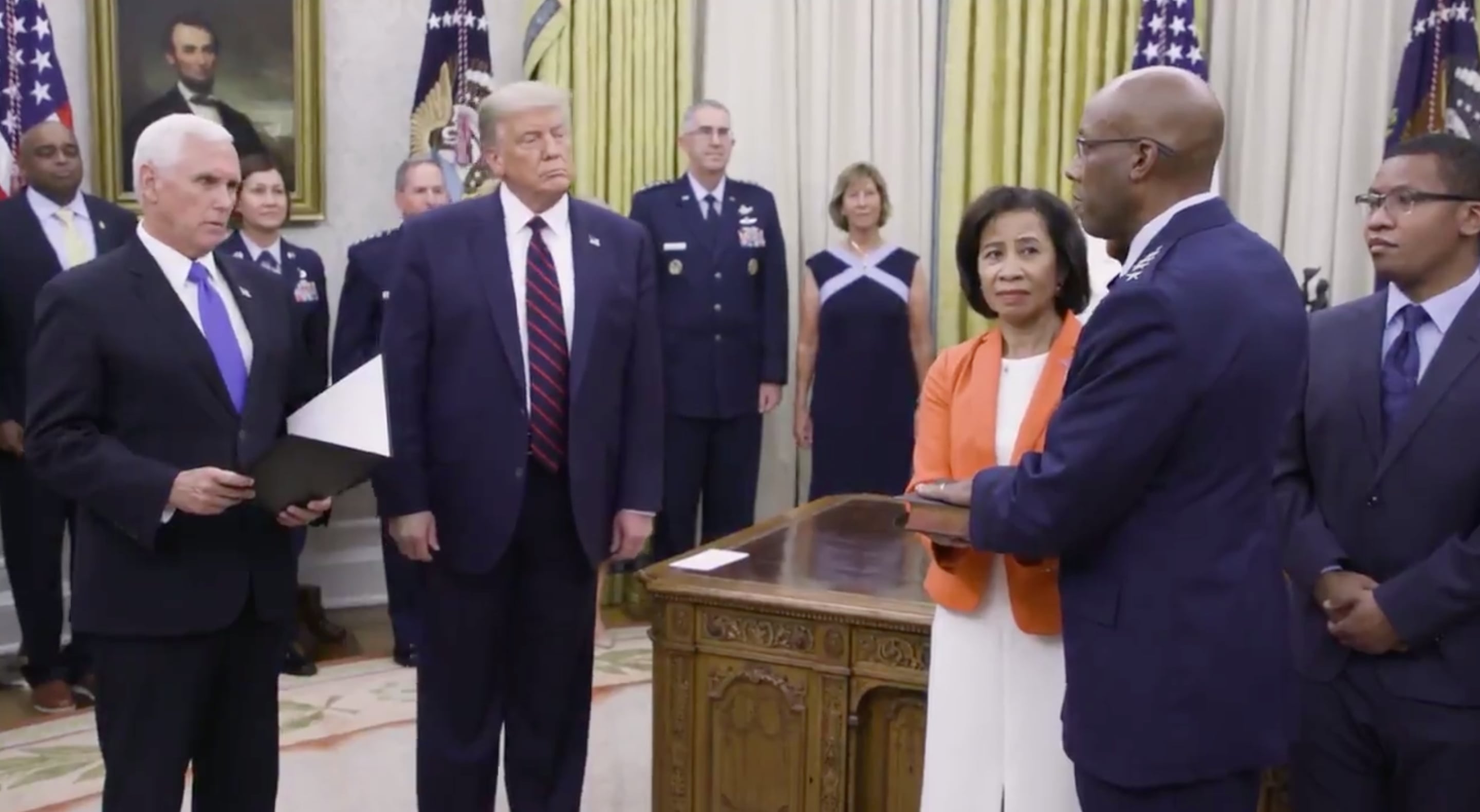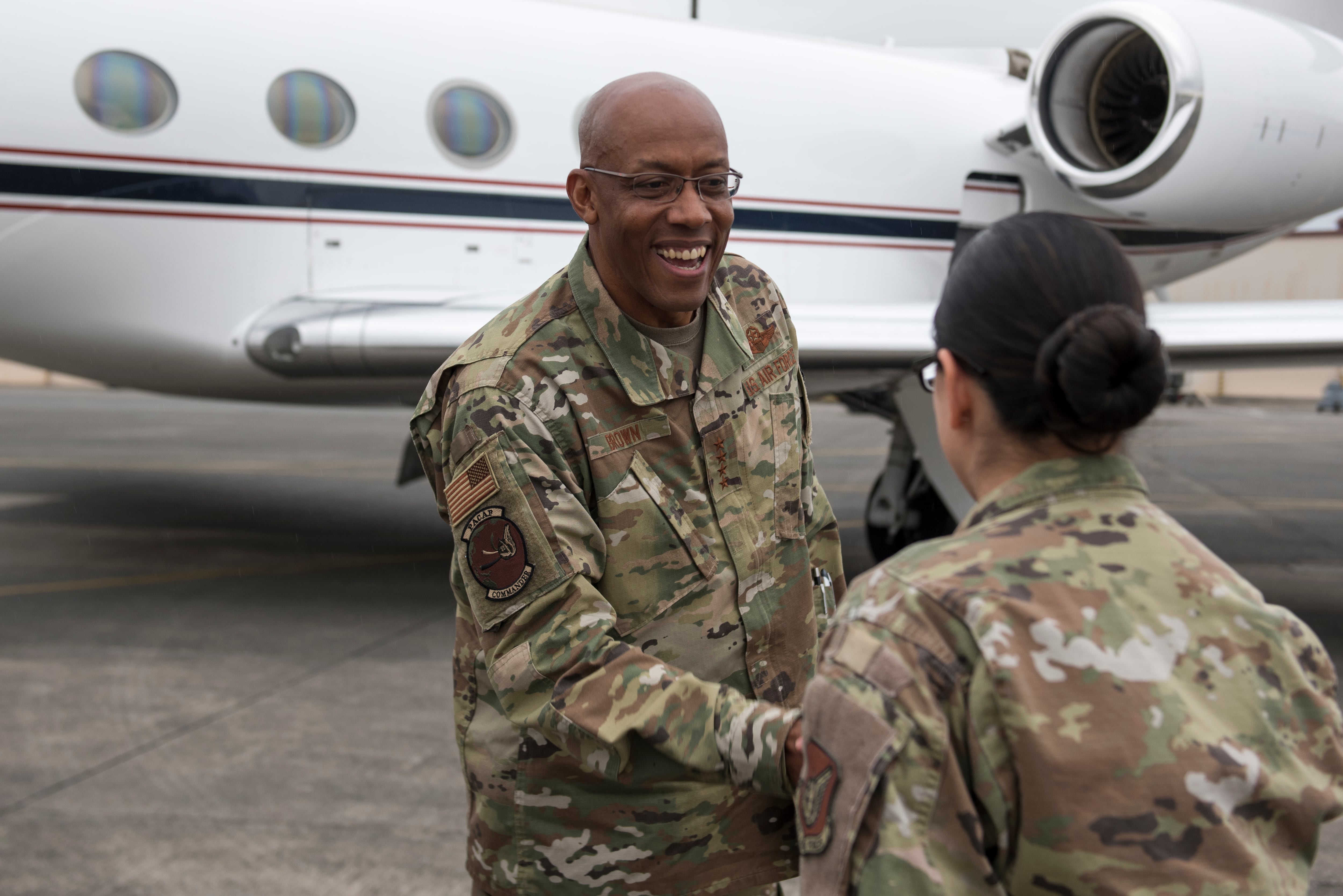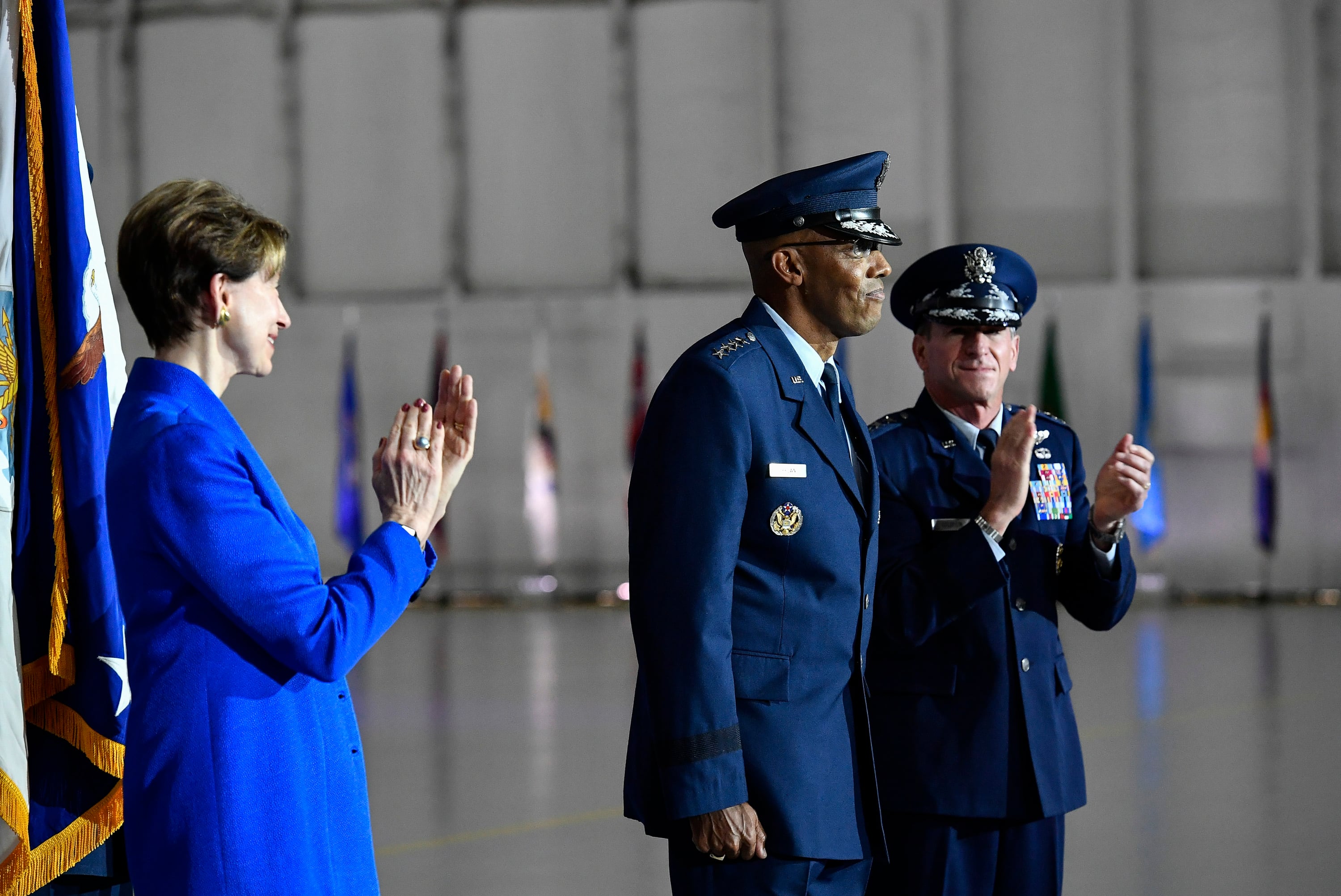Gen. Charles “CQ” Brown assumed command of the Air Force as its 22nd chief of staff Thursday in a ceremony at Joint Base Andrews in Maryland.
Brown succeeded Gen. Dave Goldfein, the chief of staff since 2016, who retired at the ceremony.
Air Force Secretary Barbara Barrett oversaw the symbolic passing of the flag, marking the change of leadership from Goldfein to Brown, with Chief Master Sergeant of the Air Force Kaleth Wright holding the flag. Barrett then swore in Brown, with his wife, Sharene, holding the traditional Bible used to swear in chiefs of staff since Gen. Carl Spaatz.
Wright presented Brown with the traditional service cap worn by chiefs of staff, which is embellished with clouds, darts and lightning bolts.
“I’m simply in awe today,” Brown said. “I’m in awe that I’m even standing here as the 22nd Air Force chief of staff, considering I had only planned to stay in the Air Force four years, and I almost quit ROTC after the first semester. Yet here I am, in a position I never thought imaginable.”

The ceremony took place in the shadow of a P-51 Mustang, alluding to the historic nature of Brown’s leadership as the U.S. military’s first-ever Black service chief. The famed and skilled Tuskegee Airmen of World War II, who fought against racial discrimination to become the military’s first Black fighter pilots, flew P-51s painted with distinctive red tails.
RELATED

Brown also saluted the Tuskegee Airmen in his remarks, tipping his hat to pioneering airmen Gen. Daniel “Chappie” James, the first Black officer to hold the rank of four-star general, Gen. Benjamin Davis and Brig. Gen. Charles McGee. And he thanked Ed Dwight, the Air Force pilot who became the first Black astronaut candidate, who attended the ceremony at Andrews.
“This is a very historic day, and I do not take this moment lightly,” Brown said. “Today is possible due to the perseverance of those who went before me, serving as an inspiration for me and so many others.”
Brown, an experienced F-16 pilot with more than 2,900 flight hours, was commissioned as an officer in 1984, after graduating from Texas Tech University.
He has a wide range of operational and joint experience. As head of U.S. Air Forces Central Command in 2015 and 2016, Brown oversaw the air war against the Islamic State. He then served as deputy commander of U.S. Central Command, before assuming command of Pacific Air Forces and its 46,000 airmen in July 2018.
RELATED

Goldfein, who has worked with and been friends with Brown for decades, praised his successor in his parting remarks.
“Dawn [Goldfein] and I could not be more excited to watch our Air Force and our airmen flourish under CQ’s and Sharene’s proven and talented leadership,” Goldfein said. “The future of our Air Force has never been brighter.”

In his remarks, Defense Secretary Mark Esper honored Goldfein for his 37 years in uniform and his work as chief of staff.
Esper praised Goldfein for his work leading the Air Force as it shifted to a new National Defense Strategy focusing on preparing for a conflict with major nations instead of smaller violent extremist groups.
Esper singled out Goldfein’s work to revitalize the squadron structure in the Air Force and improve how the service produces leaders who are able to serve in a joint environment alongside other services.
“Because of Gen. Goldfein, the core fighting units of the Air Force are much stronger, and airmen are better prepared to lead in a joint environment,” Esper said.
And he highlighted Goldfein’s work to create the B-21 bomber, advanced technologies such as hypersonics, joint all-domain command and control, and a new Space Force.
The Defense Department and the American people rely on leaders like Gen. David Goldfein, who can think years and decades ahead, preparing the nation for the unknown,” Esper said. “It’s that thinking, not hardware or tactics alone, that will protect our country.”
Goldfein’s leadership has allowed the Air Force to continue operating despite the worldwide coronavirus pandemic, Esper said.
Barrett saluted Goldfein for his daring in combat. During the Gulf War in 1991, she said, Goldfein led a multi-national force on a search-and-rescue mission over Iraq for a downed Harrier pilot, earning him the first of two Distinguished Flying Crosses with Valor.
“When others were forced to abandon the search, he alone repeatedly patrolled the aircraft’s last known position until he eventually contacted the downed pilot,” Barrett said. “With disregard for his own safety, he suppressed the enemy fire until American forces were able to rescue the pilot.”
She also retold the story of Goldfein’s shoot-down over Serbia and subsequent daring rescue out of enemy territory.
“After this, any mere mortal might reassess his career choice, or at least spend a few days calming jittery nerves,” Barrett said. “But not David Goldfein. The very next night, he flew another combat mission. Dave Goldfein is an extraordinary warrior.”
Barrett also saluted Goldfein as the “driving force” behind the effort to get the late Master Sgt. John Chapman the Medal of Honor for his bravery during the Battle of Takur Ghar in Afghanistan in 2002.
“Gen. Goldfein fought through bureaucratic resistance and red tape to award John Chapman the recognition that he earned,” Barrett said.
Goldfein’s daughter, Capt. Danielle Fleming, read her father his retirement orders.
Stephen Losey is the air warfare reporter for Defense News. He previously covered leadership and personnel issues at Air Force Times, and the Pentagon, special operations and air warfare at Military.com. He has traveled to the Middle East to cover U.S. Air Force operations.





